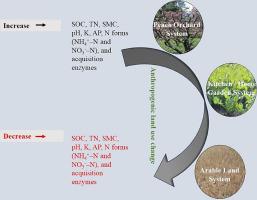Our official English website, www.x-mol.net, welcomes your feedback! (Note: you will need to create a separate account there.)
SOC and TN fluctuations determine the variations in microbial enzymatic activities under diverse land use types in the Central Himalaya, India
Catena ( IF 6.2 ) Pub Date : 2024-03-18 , DOI: 10.1016/j.catena.2024.107958 Krati Vikram , Hina Chaudhary , K.S. Rao
Catena ( IF 6.2 ) Pub Date : 2024-03-18 , DOI: 10.1016/j.catena.2024.107958 Krati Vikram , Hina Chaudhary , K.S. Rao

|
Soil microbial enzymatic activities, often used as indicators of soil health and fertility, are vulnerable to changes in climate and anthropogenic activities. This study analyses the responses of specific soil enzymatic activities– dehydrogenase (DHA), acid phosphatase (APH), β-glucosidase (BG) and urease (URE)– in Nitosols/Luvisols of the subtropical zone of the Central Himalaya, India. We investigated how these enzymatic activities vary with different land uses: arable land (AL), kitchen garden (KG) and peach orchard (PO), across four villages– Niglat, Kainchidham, Majhera and Syalikhet. Considering associated management practices, we quantified cumulative average soil enzymatic activities for the rabi season (2017–2018). In general, catalytic activity of the selected enzymes was highest in Syalikhet and lowest in Majhera. However, for land use types, enzymatic activities were lower in AL and KG (75.56–90.17% and 39.41–61.72%, respectively) compared to PO values. MANOVA analysis evaluated significant spatial differences (P < 0.001) in enzymatic activities. Soil enzymatic mean values were highest in the surface layer (0–10 cm) and decreased gradually with increasing depth. Parameters such as soil moisture content (SMC) and pH, along with vegetation, management practices, and nutrients such as SOC, TN, K, AP, and N forms (NH–N and NO–N) showed significant and strong correlations with all the soil enzyme activities ( = 0.40–0.97; P < 0.05). TN, SOC, K, SMC, pH, AP, NH- N, and clay content were key determining factors of soil enzymatic activities, explaining approximately 59% of the variation. These results suggest that using soil microbial enzymatic activities as soil quality indicators is a feasible approach to assess the impacts of vegetation, management practices, and soil profile depths in soils under different land use types/systems in selected impoverished villages of the fragile Central Himalaya, India.
中文翻译:

SOC和TN波动决定了印度喜马拉雅中部地区不同土地利用类型下微生物酶活性的变化
土壤微生物酶活性通常被用作土壤健康和肥力的指标,但很容易受到气候和人类活动变化的影响。本研究分析了印度喜马拉雅山中部亚热带地区的硝化土/Luvisols 中特定土壤酶活性——脱氢酶(DHA)、酸性磷酸酶(APH)、β-葡萄糖苷酶(BG)和脲酶(URE)的响应。我们调查了这些酶活性如何随着不同土地用途的变化而变化:耕地 (AL)、菜园 (KG) 和桃园 (PO),横跨四个村庄:Niglat、Kainchidham、Majhera 和 Syalikhet。考虑到相关的管理实践,我们量化了狂犬病季节(2017-2018)的累积平均土壤酶活性。一般来说,所选酶的催化活性在 Syalikhet 最高,在 Majhera 最低。然而,对于土地利用类型,与 PO 值相比,AL 和 KG 中的酶活性较低(分别为 75.56-90.17% 和 39.41-61.72%)。多元方差分析评估了酶活性的显着空间差异(P < 0.001)。土壤酶平均值在表层(0-10 cm)最高,并随着深度的增加而逐渐降低。土壤水分含量 (SMC) 和 pH 等参数,以及植被、管理实践和 SOC、TN、K、AP 和 N 形式(NH-N 和 NO-N)等养分,与所有参数均显示出显着且强的相关性。土壤酶活性(= 0.40–0.97;P < 0.05)。 TN、SOC、K、SMC、pH、AP、NH-N 和粘土含量是土壤酶活性的关键决定因素,解释了大约 59% 的变化。这些结果表明,使用土壤微生物酶活性作为土壤质量指标是评估脆弱的喜马拉雅中部贫困村庄不同土地利用类型/系统下植被、管理实践和土壤剖面深度影响的可行方法,印度。
更新日期:2024-03-18
中文翻译:

SOC和TN波动决定了印度喜马拉雅中部地区不同土地利用类型下微生物酶活性的变化
土壤微生物酶活性通常被用作土壤健康和肥力的指标,但很容易受到气候和人类活动变化的影响。本研究分析了印度喜马拉雅山中部亚热带地区的硝化土/Luvisols 中特定土壤酶活性——脱氢酶(DHA)、酸性磷酸酶(APH)、β-葡萄糖苷酶(BG)和脲酶(URE)的响应。我们调查了这些酶活性如何随着不同土地用途的变化而变化:耕地 (AL)、菜园 (KG) 和桃园 (PO),横跨四个村庄:Niglat、Kainchidham、Majhera 和 Syalikhet。考虑到相关的管理实践,我们量化了狂犬病季节(2017-2018)的累积平均土壤酶活性。一般来说,所选酶的催化活性在 Syalikhet 最高,在 Majhera 最低。然而,对于土地利用类型,与 PO 值相比,AL 和 KG 中的酶活性较低(分别为 75.56-90.17% 和 39.41-61.72%)。多元方差分析评估了酶活性的显着空间差异(P < 0.001)。土壤酶平均值在表层(0-10 cm)最高,并随着深度的增加而逐渐降低。土壤水分含量 (SMC) 和 pH 等参数,以及植被、管理实践和 SOC、TN、K、AP 和 N 形式(NH-N 和 NO-N)等养分,与所有参数均显示出显着且强的相关性。土壤酶活性(= 0.40–0.97;P < 0.05)。 TN、SOC、K、SMC、pH、AP、NH-N 和粘土含量是土壤酶活性的关键决定因素,解释了大约 59% 的变化。这些结果表明,使用土壤微生物酶活性作为土壤质量指标是评估脆弱的喜马拉雅中部贫困村庄不同土地利用类型/系统下植被、管理实践和土壤剖面深度影响的可行方法,印度。



























 京公网安备 11010802027423号
京公网安备 11010802027423号